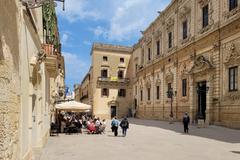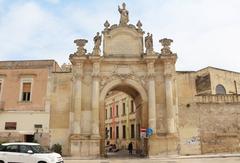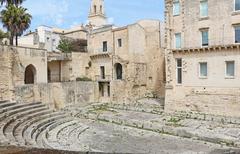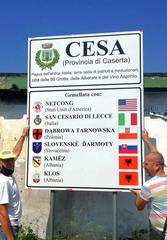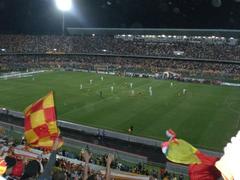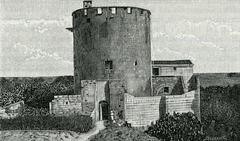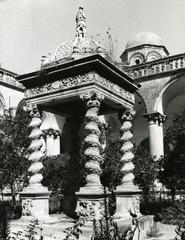
Roman Amphitheatre of Lecce: Complete Guide to Visiting Hours, Tickets, and Historical Insights
Date: 04/07/2025
Introduction
The Roman Amphitheatre of Lecce, set in the heart of Piazza Sant’Oronzo, is an enduring symbol of the city’s ancient heritage and architectural brilliance. Constructed between the late 1st century BCE and the 2nd century CE—during the reigns of Emperors Augustus and Hadrian—the amphitheatre once hosted thousands for spectacles that defined Roman public life (Eupedia; The Puglia). Today, its partially excavated ruins offer a compelling contrast to Lecce’s layered urban landscape, inviting visitors to step back in time and explore the ingenuity and social dynamics of Roman Apulia.
Historical Overview
Roman Origins and Construction
Once the heart of ancient Lupiae, the amphitheatre’s elliptical structure originally measured about 102 by 83 meters, with an arena of 53 by 34 meters. Its capacity—estimated between 12,000 and 25,000 spectators—underscores Lecce’s importance as a regional hub in the Roman Empire (Eupedia; The Puglia). Built from local tuff and the famed Lecce stone, it featured tiered seating, underground chambers (hypogeum), and a sophisticated crowd circulation system.
Rediscovery and Excavation
Centuries of urban development concealed the amphitheatre until 1901 when construction work revealed its remains (The Puglia). Now, about two-thirds of the structure is visible; the rest lies beneath later buildings, including the Church of Santa Maria della Grazia (Eupedia). This partial visibility highlights the site’s integration into Lecce’s evolving cityscape.
Architectural and Engineering Features
The amphitheatre’s design reflects advanced Roman engineering. Its elliptical plan ensured optimal sightlines, while the cavea (tiered seating) divided audiences by status. The hypogeum beneath the arena facilitated the movement of gladiators, animals, and stage machinery (Eupedia; Apulia Properties). Decorative arcades once adorned the exterior, though only fragments remain.
Social and Cultural Role
Serving as a major social and entertainment center, the amphitheatre hosted gladiatorial contests, animal hunts, and public executions—events that reinforced imperial authority and social order (The Puglia). Its scale and programming reflected Lecce’s significance as a crossroads between the Adriatic and Ionian coasts.
Transformation Through the Ages
After the Roman era, the amphitheatre fell into disuse, was quarried for materials, and became buried beneath new urban layers. Only in the 20th century did archaeological activity reclaim its place in Lecce’s identity, with restoration efforts focusing on stabilizing and showcasing what remains (Eupedia).
Visiting the Roman Amphitheatre: Practical Information
Location and Urban Context
The amphitheatre is centrally located in Piazza Sant’Oronzo, surrounded by Baroque palaces, medieval churches, and modern buildings (Atlas Obscura; Nomads Travel Guide). Notable nearby landmarks include the Column of Sant’Oronzo, Palazzo del Seggio (Il Sedile), and the INA Palace (StayCiao).
Visiting Hours
- General Opening: Daily, 9:00 AM – 7:00 PM (last admission at 6:30 PM)
- Note: Hours may change seasonally or for special events. Always check the official tourism website for the latest updates.
Tickets and Guided Tours
- Admission: Often free for the exterior/perimeter view; special exhibitions or arena floor access may require a ticket.
- Ticket Price: Standard tickets are around €6 for adults, with reductions for EU youth, students, and seniors. Children under 18 often enter free.
- Booking: Tickets and guided tours can be arranged at the entrance or through the official website or local tourist offices. Booking ahead is recommended in peak seasons.
Accessibility
- Mobility: The perimeter of the amphitheatre and main viewing areas are wheelchair accessible, with ramps and tactile models available.
- Information: Audio guides and brochures are often available; tactile 3D miniatures assist visually impaired visitors.
- Facilities: Accessible restrooms are nearby; the central piazza ensures easy movement.
Travel Tips
- Wear comfortable shoes for uneven terrain.
- Early morning or late afternoon visits offer the best lighting and fewer crowds.
- Combine your visit with other Lecce historical sites such as the Basilica di Santa Croce and the Roman Theatre.
- Check for special cultural events or performances during your stay.
Nearby Attractions and Experiences
- Basilica di Santa Croce: Famed for its ornate Baroque façade.
- Lecce Cathedral (Duomo): A must-see for art and architecture enthusiasts.
- Castello di Carlo V: A 16th-century fortress with exhibitions.
- Roman Theatre: Another ancient site illustrating Lecce’s Roman heritage.
- Local Cuisine: Enjoy pasticciotto or rustico leccese at nearby cafes.
Events and Programming
The amphitheatre regularly hosts open-air concerts, theatrical performances, and art installations, especially in summer. During festivals, it may be illuminated to stunning effect. Tickets for events are limited and should be booked in advance.
Visitor Amenities
While the amphitheatre does not have dedicated facilities, its central location means restrooms, cafes, and shops are just steps away. Souvenir shops sell guidebooks and local crafts, while nearby hotels cater to a range of budgets.
FAQs
Q: What are the Roman Amphitheatre of Lecce’s visiting hours?
A: Daily, 9:00 AM – 7:00 PM; check official sources for seasonal changes.
Q: Do I need a ticket to visit?
A: Viewing from the piazza is free; tickets may be required for arena access or special events.
Q: Is the amphitheatre accessible for wheelchair users?
A: Yes, the main perimeter is accessible, with ramps and tactile models.
Q: Are guided tours available?
A: Yes, in multiple languages; booking ahead is recommended.
Q: What else should I see nearby?
A: Basilica di Santa Croce, Lecce Cathedral, Castello di Carlo V, and the Roman Theatre.
Summary and Plan Your Visit
The Roman Amphitheatre of Lecce is not just a relic but a living monument, seamlessly woven into the city’s daily life. It offers a rare window into Roman entertainment, urban planning, and the enduring power of public space (Eupedia; Atlas Obscura). With accessible pathways, engaging tours, and a vibrant calendar of events, the amphitheatre appeals to visitors of all ages and interests. To plan a memorable visit, check official resources for updated hours and tickets, download the Audiala app for enhanced guides, and explore Lecce’s remarkable blend of Roman, Medieval, and Baroque treasures.
For more information, visit the official Lecce tourism website and consult trusted travel guides such as Lonely Planet, Trip.com, and the Lecce Sightseeing Map.
References
- This article draws upon detailed visitor guides and historical sources including Eupedia, The Puglia, Atlas Obscura, Apulia Properties, Audiala, StayCiao, and Nomads Travel Guide.








